Bile Duct cancer
CHOLANGIOCARCINOMA
What is liver?
Are you all aware of the organ which is present inside human body named liver which plays major role in sustenance of a being.
Liver is the largest organ as well as largest gland of the body with the property of regeneration.
The liver is a large, reddish-brown organ that is located in the upper right part of your abdomen, below the diaphragm and on top of your stomach, right kidney, and intestines. It's the largest organ inside your body, weighing about 3 pounds in adults.
The liver is essential for many bodily functions, including:
Filtering blood: The liver removes toxins, waste products, and excess hormones from your blood.
Producing bile: Bile is a fluid that helps break down fats in your small intestine so your body can absorb them.
Storing nutrients: The liver stores vitamins, minerals, and sugar (glucose) for your body to use later.
Making proteins: The liver produces many proteins, including some that help blood clot and fight infection.
Regulating blood sugar: The liver helps keep your blood sugar level stable.
In order to facilitate the easy distribution of the products produced by the liver and gallbladder and the formation of byproducts that are vital to our body, these tasks are carried out via a widely distributed network of ducts and tubes.These are known as bile ducts, and they are made up of three branches that each serve a specific purpose:
The common bile duct, the right hepatic duct, and the left hepatic duct.
The name "bile duct" comes from the bile juice that the gallbladder secretes, which is what our body uses to metabolise lipids (fats).
This background knowledge will aid in your comprehension of the upcoming section on bile duct cancer.
Although rare, the disease nonetheless occurs, and when it does, malignant cells enter the bile duct and interfere with its normal function, causing the disease to spread to the liver.
.
Types of bile duct cancer
There are two types of bile duct cancer:
- Intrahepatic bile duct cancer: This type of cancer forms in the bile ducts inside the liver. Only a small number of bile duct cancers are intrahepatic. Intrahepatic bile duct cancers are also called intrahepatic cholangiocarcinoma's.
- Extrahepatic bile duct cancer: This type of cancer forms in the bile ducts outside the liver. The two types of extrahepatic bile duct cancer are perihilar bile duct cancer and distal bile duct cancer:
- Perihilar bile duct cancer: This type of cancer is found in the area where the right and left bile ducts exit the liver and join to form the common hepatic duct. Perihilar bile duct cancer is also called a Klatskin tumor or perihilar cholangiocarcinoma.
- Distal bile duct cancer: This type of cancer is found in the area where the ducts from the liver and gallbladder join to form the common bile duct. The common bile duct passes through the pancreas and ends in the small intestine. Distal bile duct cancer is also called extrahepatic cholangiocarcinoma.
Signs and symptoms of bile duct cancer
These and other signs and symptoms may be caused by bile duct cancer or by other conditions. Check with your doctor if you have any of the following:
- jaundice (yellowing of the skin or whites of the eyes)
- dark urine
- clay colored stool
- pain in the abdomen
- fever
- Itchy skin
- Nausea and vomiting
- Weight loss for an unknown reason
Surgery
Treatment options for bile duct carcinoma include the following surgical procedures:
The surgical treatment known as a partial hepatectomy involves the removal of the portion of the liver containing the malignancy.
The pancreatic head, the gallbladder, a portion of the stomach, a portion of the small intestine, and the bile duct are removed during the Whipple procedure.
To improve quality of life and reduce symptoms brought on by a clogged bile duct, palliative surgery can be performed as follows:- Biliary bypass: A biliary bypass may be necessary if cancer is obstructing the bile duct and causing bile to accumulate in the gallbladder.
Endoscopic stent placement: Surgery may be necessary to insert a stent—a thin, flexible tube—to drain accumulated bile in the area if the tumour is obstructing the bile duct.
The purpose of percutaneous transhepatic biliary drainage is to take x-rays of the liver and bile ducts. A tiny needle is put into the liver through the skin beneath the ribcage.
Radiation treatment
High-energy x-rays and other radiation therapies are used in radiation therapy to either kill or stop the growth of cancer cells.
Hyperthermia therapy: High temperatures are applied to body tissue in order to increase the sensitivity of cancer cells to the effects of anti-cancer drugs.- Radiosensitizers: These medications increase the sensitivity of cancer cells to radiation treatment. Radiosensitizers and radiation therapy together may destroy more cancer cells.
- Internal radiation therapy involves inserting needles, seeds, wires, or catheters directly into or close to the bile duct, sealed with radioactive material.
Chemotherapy
Chemotherapy employs medications to either kill or prevent the division of cancer cells in order to stop their growth. Chemotherapy is used to treat bile duct cancer in two basic ways.
Systemic chemotherapy: Chemotherapy medications enter the bloodstream and can reach cancer cells all over the body whether they are given orally or injected into a vein or muscle.
Bile duct cancer that is incurable, metastatic, or recurring is treated with systemic chemotherapy. The following medications are options for chemotherapy:
*cisplatin with gemcitabine
*oxaliplatin and capecitabine (XELOX)*oxaliplatin and gemcitabine (GEMOX)
*oxaliplatin and capecitabine
Chemotherapy in a region: Chemotherapy mostly targets cancer cells in organs or body cavities like the abdomen when it is injected directly into those regions.
- Biliary bypass: A biliary bypass may be necessary if cancer is obstructing the bile duct and causing bile to accumulate in the gallbladder.










Comments
Post a Comment